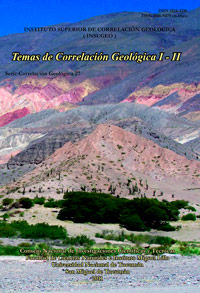Serie Correlación Geológica 27
Controles geoquímicos e isotópicos en la petrogénesis de los granitos Devónico-Carboníferos Santa Cruz y Asha: Sierra de Velasco, Argentina.
Miguel A. S. Basei | Mariano Larrovere | Juana N. Rossi | Alejandro J. Toselli
Descargar trabajo en formato PDFResumen
CONTROLES GEOQUIMICOS E ISOTOPICOS EN LA PETROGENESIS DE LOS GRANITOS DEVONICO-CARBONIFEROS SANTA CRUZ Y ASHA: SIERRA DE VELASCO, ARGENTINA.- Los plutones Santa Cruz y Asha, afloran en el flanco nororiental de la sierra de Velasco, con dirección norte sur. El Granito Santa Cruz está constituido por granitos equigranulares evolucionados, con moscovita mayor que biotita y susceptibilidad magnética de 0,10 a 0,14 x 10-3 SI. Mientras que el Granito Porfídico Asha, tiene caracteres evolutivos calco-alcalinos normales, con biotita mayor que moscovita y susceptibilidad magnética de 2 a 16 x 10-3 SI. Ambos granitos presentan valores de A/CNK > 1,1 y relaciones Rb/Sr >2. En el diagrama modal QAP ambos se proyectan superpuestos en el campo granítico. Estos granitos presentan diferencias entre si y muestran variaciones a leucogranitos. Las edades determinadas por U-Pb sobre monacitas, son de 361 +/- 4,1 Ma, para el Granito Porfídico Asha (GPA) y de 354,3 +/- 3,8 Ma, para el Granito Santa Cruz (GSC), estableciendo que las intrusiones se produjeron en el Devónico superior - Carbonífero inferior. Estos granitos son algo más antiguos que los granitos San Blas, Huaco y Sanagasta, de la Sierra de Velasco. El GSC tiene más bajos contenidos de Fe2O3t, MgO, CaO, TiO2 y valores más altos en SiO2, Al2O3, K2O, P2O5. Los elementos trazas (Sr, Ba, V, Sc y Σ REE) son más altos que los del GSC, aunque ambos presentan marcada anomalía negativa de Eu. Muestra asimismo menor contenido en Tierras Raras totales que el GPA. Ambos granitos muestran bajos contenidos de Sr (<200 ppm). Los datos geoquímicos sugieren que los granitos se habrían originado a partir de fuentes diferentes dominadas por metagrauvacas con metabasitas. Los valores eNdt de -6,01 para el GSC y de -5,41 para el GPA, sugieren proveniencia cortical de los fundidos graníticos, y las edades modelo obtenidas de 1.586 Ma para el GSC y de 1.538 Ma para el GPA, indican el tiempo de residencia en una corteza Mesoproterozoica inferior, al contrario de los granitos del Devónico- Carbonífero de la misma sierra previamente investigados (San Blas, La Chinchilla eNdt promedio -1,3; TDM 1.156 Ma) y los granitos Huaco y Sanagasta que tienen eNdt promedio: -3,32 y TDM: 1.323 Ma, con tiempo de residencia en la corteza Mesoproterozoica superior. El índice de fraccionamiento de ƒSm/Nd y las edades modelo de Nd de ambos granitos son coincidentes con los de la Formación Puncoviscana y podrían haberse formado por un proceso strike-slip a profundidades diferentes.
Abstract
GEOCHEMICAL AND ISOTOPIC CONSTRAINTS ON PETROGENESIS OF DEVONIAN-CARBONIFEROUS SANTA CRUZ AND ASHA GRANITES: SIERRA DE VELASCO, ARGENTINA.-The Santa Cruz and Asha granites crop out as north-south striking associated plutons in the northeast sector of the Sierra de Velasco. Even though both granites have been emplaced nearly synchronous, they are clearly different in their textural and geochemical characteristics. The Santa Cruz Granite is a medium-grained equigranular monzogranite, in which muscovite predominates over biotite, and the magnetic susceptibility is 0.10 - 0.14 x 10-3 IS units. The Porphyritic Asha Granite is a coarse-grained porphyritic monzogranite with biotite largely predominating over muscovite. The magnetic susceptibility is 2 to 16 x 10-3 IS units. Both granites present A/CNK > 1,1 and have Rb/Sr > 2. In a modal QAP, both granites are project on the granite field. A U-Pb monazite age was of 361+/- 4.1 Ma for the Porphyritic Asha Granite (GPA) and 354.3 +/-3.8 Ma for the Santa Cruz Granite (GSC). These data indicate that the intrusions took place during the Upper Devonian to the Lower Carboniferous. The Fe2O3, MgO, CaO and TiO2 values are significantly lower, and SiO2 , Al2O3 , K2O and P2O5 are higher than those in GPA. Trace elements (Sr, Ba, V, Sc and Σ REE) are higher than those in GSC, although both showed marked negative Eu anomaly. Both granites show low content of Sr (<200 ppm). The geochemical data of both granites plotted on different diagrams in comparison with experimental diagrams melts, suggesting a metagreywackes in transition to metabasites as dominated sources, corresponding to crustal provenance. On the tectonic setting diagrams the granites fit into a continental collision scheme. The Sm-Nd isotopic geochemistry yields eNdt of -6,01 for GSC and eNdt of -5,41 for GPA, and the Nd model ages of 1586 Ma for the GSC and 1538 Ma for the GPA, in the same range as the Famatinian Arc of the Central Sierras Pampeanas. The Sm/Nd fractionation index (ƒSm/Nd) and the Nd model ages of both granites are close to those of the Puncoviscana Formation. This suggests that the Puncoviscana Formation could be the source of generation of both granites, through a process of strike-slip.






